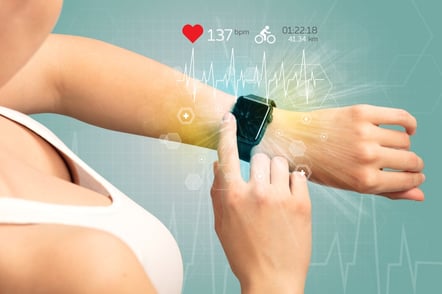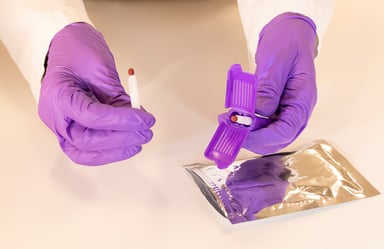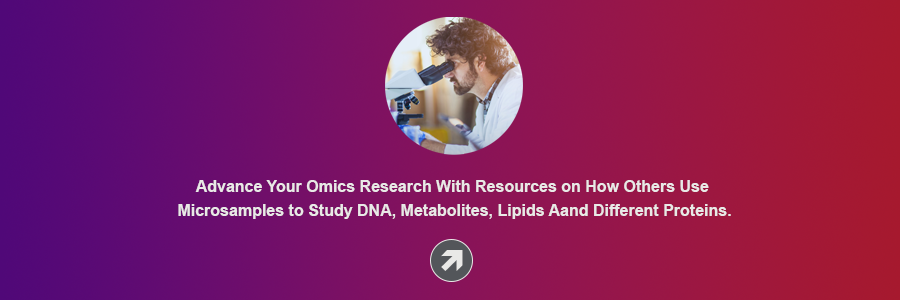Share this
a breakthrough in capillary blood sampling for multi-omics studies
by James Rudge, PhD, Technical Director, Trajan on Mar 20, 2023 9:00:00 AM
Part 1: Multi-omics Approach Pioneered by Stanford University
In January 2023, a research group led by Michael Snyder, PhD, at Stanford Medicine in California published a paper in Nature Biomedical Engineering on their multi-omics research approach, including combined data from blood microsamples and wearables.
The paper, titled “Multi-omics microsampling for the profiling of lifestyle-associated changes in health,” demonstrated the huge potential of obtaining useful multi-omics data from just two 10 µL Mitra® microsamples per sampling point, negating the need for phlebotomy in such studies.
The research was a success and the authors concluded that microsampling in omics studies “offers a promising opportunity to integrate with wearable data to improve precision healthcare.”

A Mitra® device can be used by virtually anyone, anytime, anywhere for capillary blood sampling.
New Research Approaches for a Rapidly Changing Way of Life
The pace of science and technology is moving at an incredible rate. Indeed, it is thought that our lives will be transformed over the next decade or so to the same degree that the industrial and internet revolutions impacted lives in past generations.
This transformation is primarily a result of the rise of big data and artificial intelligence influencing every element of our lives.
As a result, we are going to see huge developments in many fields, including biology, medicine, engineering, and clinical testing. Big data and the amazing progress in analytical technologies are going to allow us to personalize and modernize clinical tests to allow us to keep pace with the rapid progress in personalized treatments, such as CAR T therapy and other major medical breakthroughs.
Microsampling May Transform Clinical Testing: A New Way to Monitor Health
In the coming years, there is a desire to transition away from traditional blood tests using multiple tubes of wet blood. Traditional blood tests often measure single analytes or small panels of molecules referenced against population values to help diagnose and/or monitor disease.
Instead, it is hoped that clinical science will transition towards longitudinal tests and preventive and personalized medicine, where data will be collected from the “multi-ome” of an individual throughout their lives. An individual’s multi-ome will provide a framework for understanding their ‘well state’ baseline health compared to indicators of disease or conditions that impact their health status.
 The great promise of this approach is that multi-omics analyses, in combination with ‘live data’ obtained from wearables (e.g., smartwatches), will paint a real-time picture of an individual’s health status with precision.
The great promise of this approach is that multi-omics analyses, in combination with ‘live data’ obtained from wearables (e.g., smartwatches), will paint a real-time picture of an individual’s health status with precision.
Over the course of a person’s life, it is anticipated that any perturbations in biological markers will be caught early with this approach, which would allow for early intervention and prevention of disease onset.
Potential Barriers & Benefits to Adoption
There are, of course, barriers to adoption of such advanced or “disruptive” technologies. For example, the need for vast computing power and data storage to deploy longitudinal multi-omics surveillance to serve a wider population.
A benefit to consider, though, is the increased convenience and cost savings to be realized if people can reduce the number of regular visits they make to clinics and labs for blood tests. For people who are being monitored for chronic diseases, those visits are typically quite frequent and may also involve overnight stays.
By moving blood sample collection from the clinic or lab and into a person's home via self-sampling devices and kits, we can increase convenience and allow for more frequent sample collection.
 Indeed, volumetric microsampling tools, such as the Mitra device with VAMS® technology and the hemaPEN® with volumetric DBS technology, have been successfully used in many remote studies.
Indeed, volumetric microsampling tools, such as the Mitra device with VAMS® technology and the hemaPEN® with volumetric DBS technology, have been successfully used in many remote studies.
Some remote studies have been those utilizing proteomic, metabolomic and lipidomic approaches. These studies demonstrate that it is possible to obtain multi-omics data from microsamples of dried capillary blood.
The work by Michael Snyder’s group is the focus of this blog, which is part 1 of 2 blogs in which we will delve into their approach and methodology used to validate their multi-omics method.
In part 2, we will summarize two studies reported in the research paper by the Snyder Lab, discussing the utility and potential of combining multi-omics data with capillary sample collection, and combining this with data obtained from wearables.
Why use VAMS samples over alternatives?
The Snyder Lab research group commented in their paper that traditional blood collection via venipuncture draws too high a blood volume for the frequent collection needed for longitudinal tests. They pointed out that, in some cases, several collection events may need to be conducted during the course of a single day, making venipuncture a challenge.
In relation to capillary microsampling approaches as an alternative, the authors also pointed out the limitations of conventional dried blood spot (DBS) cards. They noted that DBS cards often result in inconsistent sampling, stating “DBS sampling is often irreproducible since volumetric amounts can vary considerably and, so far, the number of analytes analyzed from DBS has generally been modest.”
For these reasons, the group chose to use Mitra devices with VAMS technology, due to their volumetric nature and precision, which helped them to circumvent issues experienced with the legacy technique (DBS).
Analytical Method and Results of the Multi-omics Blood Sampling Study
Sample preparation from Mitra microsamples included different steps and experiments, as follows:
- Three separate sequential extractions were conducted from one 10 µL VAMS tip on a Mitra device to obtain 3 ‘fractions’ consisting of lipids, polar metabolomics and peptides, respectively. The extracts were analyzed by LC-MS/MS.
- The group also used a second Mitra device for whole protein and hormone extraction including cytokines, cortisol and protein-based hormones. These were analyzed by high-sensitivity multiplex immunoassay.
- Using this combined approach, they identified 180 proteins, 1,461 annotated metabolomics features, and 776 lipids.
Experiments included:
- Stability of proteins, metabolites and lipids on Mitra devices under different storage conditions.
- Samples were collected from 2 volunteers (36 samples each), dried and then stored under the following temperatures: 4, 25 and 37 °C; over the following durations: 3, 6, 24, 72 and 120 h. Each were then placed in a −80 °C freezer until analysis. As a control, samples were stored immediately at –80 °C.
- Many analytes on samples appeared to be quite stable, with proteins showing the highest stability, and lipids showing the least stability. For the analytes that were affected, the group determined it was due to both duration and temperature.
- They, however, concluded that most analytes could be measured using remote sampling. Moreover, by using correction models, some of the less stable molecules could also be identified.
- Samples were collected from 2 volunteers (36 samples each), dried and then stored under the following temperatures: 4, 25 and 37 °C; over the following durations: 3, 6, 24, 72 and 120 h. Each were then placed in a −80 °C freezer until analysis. As a control, samples were stored immediately at –80 °C.
- A comparison of dried blood microsampling compared to conventional wet venous plasma sampling.
- Samples from 34 participants showed good spearman correlations for metabolites (n=642, 0.81 (P < 0.001) and lipids (n=616, 0.94, (P<0.001)) though the correlation dropped (<0.5) when amino acids and triglycerides were enriched in the sample set. However, the researchers said that for most classes of molecule (amino acids, carbohydrates, free fatty acids, triglycerides, diglycerides and phosphatidylcholines) the data was very similar.
- Samples from 34 participants showed good spearman correlations for metabolites (n=642, 0.81 (P < 0.001) and lipids (n=616, 0.94, (P<0.001)) though the correlation dropped (<0.5) when amino acids and triglycerides were enriched in the sample set. However, the researchers said that for most classes of molecule (amino acids, carbohydrates, free fatty acids, triglycerides, diglycerides and phosphatidylcholines) the data was very similar.
- Two human studies (discussed in our next blog, part 2).
- The first (n=28 fasting participants) was to investigate changes in omic biomarker levels over 240 minutes and post consumption of an ‘Ensure’ nutrition shake.
- The second study (n=1 participant) involved collecting 98 microsamples over a two-week period, where in-depth omics profiling was conducted. This data was then analyzed with data generated from a smartwatch (heart rate, steps and sleep) and a continuous blood glucose monitoring device.
- The first (n=28 fasting participants) was to investigate changes in omic biomarker levels over 240 minutes and post consumption of an ‘Ensure’ nutrition shake.
Multi-Omics Study Authors’ Findings
- The group developed a multi-omics approach to measure thousands of analytes, including proteins, metabolites and lipids from 10 µL Mitra microsampling devices.
- Compared to standard sampling, most molecules were consistent from dried blood Mitra with VAMS devices.
- For the collection event, the participants didn’t require Mitra-VAMS training, which allowed for very frequent self-sampling as a benefit compared to venous blood sample collection.
- Most analytes, especially proteins (e.g., many cytokines), appeared stable. Even where some analytes were less stable, it was possible to analyze degraded products and then correlate back to the original analyte.
- Types of application included longitudinal biomarker studies, monitoring of personalized health and therapeutic drug monitoring.
To learn more about the application of VAMS Microsampling in Omics research please visit our resource page.
This article was summarized for our readers by James Rudge, PhD, Neoteryx Technical Director. This is curated content. To learn more about the important research outlined in this blog, visit the original article in Nature Biomedical Engineering.
Access published, peer-reviewed papers on similar microsampling research studies in our Technical Resource Library.
Image credits: iStock, Trajan Scientific and Medical
Share this
- Microsampling (206)
- Research, Remote Research (119)
- Venipuncture Alternative (105)
- Clinical Trials, Clinical Research (83)
- Mitra® Device (73)
- Therapeutic Drug Monitoring, TDM (51)
- Dried Blood Spot, DBS (39)
- Biomonitoring, Health, Wellness (30)
- Infectious Disease, Vaccines, COVID-19 (24)
- Blood Microsampling, Serology (23)
- Omics, Multi-Omics (21)
- Decentralized Clinical Trial (DCT) (20)
- Specimen Collection (18)
- Toxicology, Doping, Drug/Alcohol Monitoring, PEth (17)
- Skin Microsampling, Microbiopsy (14)
- hemaPEN® Device (13)
- Preclinical Research, Animal Studies (12)
- Pharmaceuticals, Drug Development (9)
- Harpera Device (7)
- Industry News, Microsampling News (5)
- Antibodies, MAbs (3)
- Company Press Release, Product Press Release (3)
- Environmental Toxins, Exposures (1)
- July 2025 (1)
- May 2025 (1)
- April 2025 (2)
- December 2024 (2)
- November 2024 (1)
- October 2024 (3)
- September 2024 (1)
- June 2024 (1)
- May 2024 (1)
- April 2024 (4)
- March 2024 (1)
- February 2024 (2)
- January 2024 (4)
- December 2023 (3)
- November 2023 (3)
- October 2023 (3)
- September 2023 (3)
- July 2023 (3)
- June 2023 (2)
- April 2023 (2)
- March 2023 (2)
- February 2023 (2)
- January 2023 (3)
- December 2022 (2)
- November 2022 (3)
- October 2022 (4)
- September 2022 (3)
- August 2022 (5)
- July 2022 (2)
- June 2022 (2)
- May 2022 (4)
- April 2022 (3)
- March 2022 (3)
- February 2022 (4)
- January 2022 (5)
- December 2021 (3)
- November 2021 (5)
- October 2021 (3)
- September 2021 (3)
- August 2021 (4)
- July 2021 (4)
- June 2021 (4)
- May 2021 (4)
- April 2021 (3)
- March 2021 (5)
- February 2021 (4)
- January 2021 (4)
- December 2020 (3)
- November 2020 (5)
- October 2020 (4)
- September 2020 (3)
- August 2020 (3)
- July 2020 (6)
- June 2020 (4)
- May 2020 (4)
- April 2020 (3)
- March 2020 (6)
- February 2020 (3)
- January 2020 (4)
- December 2019 (5)
- November 2019 (4)
- October 2019 (2)
- September 2019 (4)
- August 2019 (4)
- July 2019 (3)
- June 2019 (7)
- May 2019 (6)
- April 2019 (5)
- March 2019 (6)
- February 2019 (5)
- January 2019 (8)
- December 2018 (3)
- November 2018 (4)
- October 2018 (7)
- September 2018 (6)
- August 2018 (5)
- July 2018 (8)
- June 2018 (6)
- May 2018 (5)
- April 2018 (6)
- March 2018 (4)
- February 2018 (6)
- January 2018 (4)
- December 2017 (2)
- November 2017 (3)
- October 2017 (2)
- September 2017 (4)
- August 2017 (2)
- July 2017 (4)
- June 2017 (5)
- May 2017 (6)
- April 2017 (6)
- March 2017 (5)
- February 2017 (4)
- January 2017 (1)
- July 2016 (3)
- May 2016 (1)
- April 2016 (2)



Comments (2)